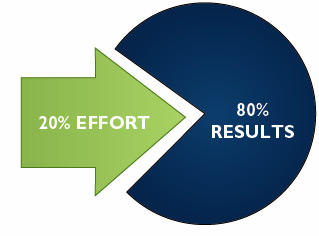When to Revise Your Website vs. When to Redesign It
Am I nuts?! Why would I, the owner of a web design and marketing agency say that? Am I trying to make a fine distinction about the word “need?” Or is it just a provocative headline?
Maybe a little of both, but mostly I’d like to share my observation that as times are changing, so is the way we look at your website. Any of these things may be causing you stress and making you think you need a new website:
- Your web analytics show a drop in performance.
- Your brand message has changed.
- You’re introducing a major new product.
- Your CEO is unhappy with it.
- Your site is not “Responsive” (designed for the mobile environment).
- Your competition has a great b2b website.
The 80/20 Rule – Revise Vs. Rebuild
With most organizations’ websites, 80% of their traffic comes to 20% of their pages, give or take. You may find that an” iterative approach” to fixing your website, versus creating a whole new site at once, will provide the most ROI in the shortest period of time.

How do you decide if the 80/20 approach will work for you?
Little Budget, Little Time – Most marketers have limited budgets and multiple initiatives. If you do not have the funds or the months it takes to do a full website overhaul, you may not need to wait. The web is malleable; “continuous improvement” can be a viable strategy for the right situation:
You Already Take a Data-Driven Approach – You will only know for sure what 20% of pages are driving 80% of traffic, if you are looking at your web analytics regularly, which I highly recommend. With this approach, you can “cherry pick” your changes and measure the impact on an ongoing basis.
You Need Maximum Flexibility – Your business is in transition. Team members you need are not available, yet your site needs changes. Think small / targeted updates, rather than total rebuild.
Your Messaging is in Transition – I often stress that a website’s success pivots on the messaging. If the messaging is in flux, it may be wise to do some A/B Testing, trying out variations of the messaging on key pages and CTAs. The user data from these tests will inform your future site’s messaging when you’re ready to do the full site.
You are Comfortable Working Iteratively – The web today puts a greater emphasis on speed and iteration. It’s ok to get things up quickly, measure and refine, but you have to be comfortable with not checking things off your list so quickly. Working iteratively or “continuous optimization” is a mind shift, especially for very task-driven people.
When Is a Brand New Website the Correct Approach?
When You’re Starting Up – As a startup company without a site or perhaps with a one-page placeholder, you need to bite the bullet and create a brand new site. The good news is that at this stage you probably don’t have a lot of content, you need just enough to appear as a serious company.
When Most or all Content is Changing – When considering a new site, take an inventory of your existing content. If it is mostly obsolete, chances are that enough has changed and you need a new site with new design, architecture and content, to represent your brand in a more current manner.
When Information Architecture Needs to Change – The information architecture is the structure of your site and defines what your content is and where to find it. Information architecture is dependent on your web audiences, what you want them to do and where you want them to go. When you need changes here, it generally signifies that important things have changed in your business that will be best expressed through a new website.
Your Content Strategy has Changed – The website is a customer engagement tool and the chief agent of that engagement is the content you offer and the user experience in which that content is packaged. If your content strategy is brand new, a new site is probably warranted.
To Signify a Major Change in Your Organization – Maybe you’ve merged or acquired another significant company; maybe you’re launching a brand new flagship product; perhaps there is a major event in which you are making an important announcement. Major events or inflection points are perfect opportunities to support with a new website.
When There is A Lot of Complexity – If your business is complex, with many products, solutions, divisions, languages or content types, it may be difficult to employ the 80/20 approach and making small changes may cascade into larger changes when all of the dependencies are considered.
When a New Brand Strategy is in Place – A rebrand is the perfect time for a new site. With most complete rebrands, you want a clear delineation between how the company was presented before, versus how you are presenting it now. A new site is the most visible way to make that change apparent to the largest audience.
Flexible Solutions for Changing Times?
The good news conclusion is that there is no longer a “One Size Fits All” approach to your website. By evaluating the changing needs and behaviors of your online audiences and your own needs, you can decide whether you are best served by a brand new website or if the 80/20 approach is a viable option.
